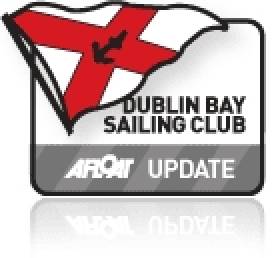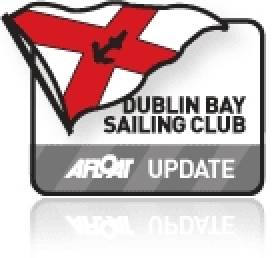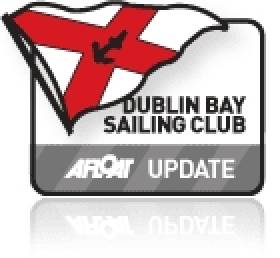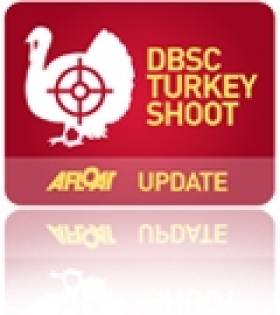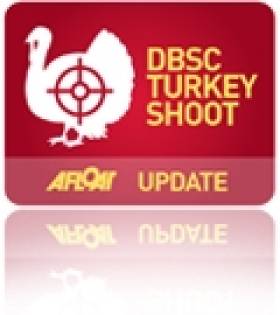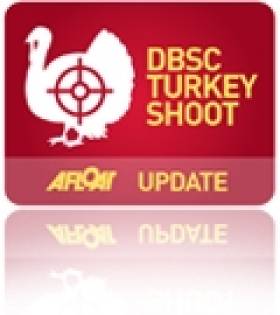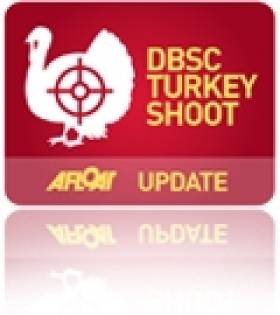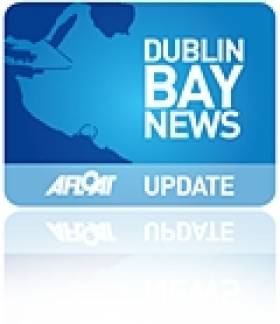Displaying items by tag: DBSC
Is Dublin Bay Sailing Club (DBSC) The Most Effective Sailing Organisation in the World?
#dbsc – Ireland's largest yacht racing organisation is Dublin Bay Sailing Club (DBSC), which administers the regular weekly programme for the entire Dun Laoghaire fleet. It has been such an accepted part of sailing's furniture for so long that it might be too easily taken for granted. W M Nixon salutes one of the great cornerstones of our world afloat.
Dublin Bay Sailing Club is 130 years old this year. Founded in 1884, it shares a birth year with the Gaelic Athletic Association. That's something I'd seldom heard mentioned by anyone, if at all, until the point was made in his foreword to the up-coming DBSC Yearbook 2014 by Commodore Pat Shannon. Yet it's a coincidence which is both incidental and fundamental. The two organisations in their very different ways are central to the areas of Irish life they serve so very well.
Perhaps the shared birth year goes unremarked simply because it's so bleeding obvious. So while we're on statements of fact from the IBO (the Institute of the Bleeding Obvious), might we be permitted another suggestion in that line? Sometimes, people from elsewhere wonder why major championships in GAA headquarters at Croke Park attract such enormous crowds, with upwards of 80,000 people roaring their hearts out. Naturally we'll respond to these outside enquiries with highfalutin lyricism about the sporting expression of Ireland in all her glory, the shared emotions, the rural soul of the nation. But on the other hand, at the end of the day (as they say in stadium sports), is it not something to do with the fact that, in our Gaelic sports, an Irish team always wins?
Be that as it may, there is equally something very Irish but also quintessentially Dublin – south Dublin, to be precise – about Dublin Bay SC. Its success owes much to the three great Ps – population, prosperity, and proximity. While most of the great cities of the world are coastal to some extent, few of them share Dublin's almost unique combination of circumstances which more or less force DBSC to thrive, even if today it is very different from the small boat sailing group which was set up in 1884.
Although the city is superbly situated on a graceful bay, the waters of Dublin Bay lend themselves much better to racing than cruising. You can have yourself a fine little cruise with many different natural mini ports of call within Sydney Harbour, and San Francisco is the same. As for the Solent or New York, or Washington and Baltimore, the choice of desirable sailing destinations within very easy reach is almost bewildering.
But in south Dublin, you have this intensely packed mostly affluent population crowded in along a fairly short bit of coastline, based around a large but entirely artificial harbour at Dun Laoghaire. There's immediate access to a rather open bay, but with no other proper harbours of significance within easy reach of an hour's sail other than Dublin Port itself. In such a location and with only two or three hours of spare time, what else can you do with a sailing boat but go racing?

The veteran Nich 31 Saki is one of the regular participants in DBSC Class 3 racing in Dublin Bay. So eclectic is the Dublin Bay cruiser fleet that Saki is by no means the most hefty boat regularly raced. Photo: David O'Brien
Thus one of the great strengths of DBSC, in its role as the overall racing body for the entire Dun Laoghaire fleet, is the provision of regular racing for large cruiser fleets which include some craft which, at any other port, would not be considered a racing proposition at all. But thanks to the sheer numbers of people wanting to get out and afloat and get a bit of fresh air on a Thursday night or Saturday afternoon or whenever, plus the impressive number of backroom volunteers who are prepared to record and analyse the results when they're provided with the elapsed times from real racing, an accurate picture of performance potential and a meaningful handicap system for just about anything that sails can evolve.
Obviously for this sort of intensely localised sport, a One Design class provides the most immediate return in quality of racing. And not surprisingly over the years, DBSC has been a stronghold and world leader of the One Design ideal. But it is a big enough and generous enough organisation to accept and accommodate a high level of individuality in boats and their owners, and the result at the height of the season is a social, sporting and seafaring phenomenon. People flock wearily homewards from work in the crowded city yet somehow - within minutes – they can be transformed into fully kitted energetic sailors out on the bay, shaping up for a start.
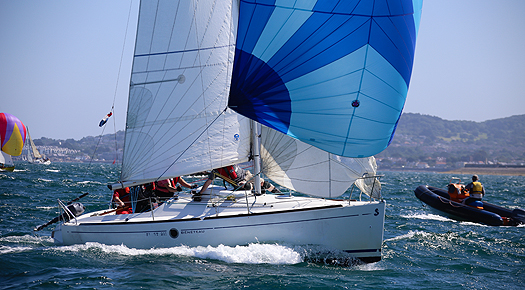
The 'new' Dublin Bay 21s, a contemporary Dublin Bay One design class. Photo: David O'Brien
But one way or another, Dun Laoghaire has a plethora of sailing clubs and organisations. How is it that the little club formed by Richard Fry and Dr W M A Wright and half a dozen friends in July1884 has become so pre-eminent? For, faced with a harbour dominated by the impressive clubhouses of the three established yacht clubs, DBSC's initial ambitions were very modest indeed, the club ethos being stated thus:
"In order to provide as much sport as possible with a minimum of expense, the races are to be strictly limited to open-sea boats with a light draught of water, such as can be easily rowed and beached if necessary".
Certainly as our lead photo from 1886 clearly shows, they fulfilled their original intentions to the letter. Yet within a dozen years, this unassuming little house-less club was promoting classes of substantial one design keelboats, and numbering among its active ordinary membership such social eminences as the Viceroy and other aristocrats who sailed.
At the time, the Royal Alfred Yacht Club, likewise a Dublin-based Corinthian organisation which functioned without a clubhouse, would have been expected to set the racing pace among the upper echelons of society. But the Alfred maybe set its sailing ambitions too high. Since 1870, it had been the lead club in formulating and developing the rules of yacht racing at national and international level. And it had always been a leading player in developing early offshore racing, with its Channel Matches an accepted part of the scene for many years.

A Royal Alfred YC Channel Match gets started in Dublin Bay in 1888. While the RAYC was promoting its ideals internationally and providing challenges for larger craft, Dublin Bay SC was quietly building its strength in their shared home waters with local boats.
Thus the Alfred's sights were set too high to cater for everyday Dublin Bay racing, week after week. Then too, over the years, its name became meaningless. While it meant a lot in 1870, subsequently there'd be those who'd think Royal was a brand of custard, and as for Alfred, wasn't he the dim son of Queen Victoria who'd been named after the guy who burnt the cakes?
But Dublin Bay Sailing Club......now there's a brand name to kill for. Whether it's prawns or people or boats or places, Dublin Bay has a zing. Clearcut, instantly recognisable, homely yet stylish, utterly reassuring, and only three very distinct syllables in just nine letters – Dublin Bay is a winner. In fact, you'd need to mess around big time to screw up the performance of an organisation called Dublin Bay Sailing Club. But happily there's never been any chance of that, as Dublin Bay SC dynamically reflects the basically very stable and successful society in which it is located.
An outsider looking at the history of Ireland in the first half of the 20th Century would wonder at this claim of "stable and successful". After all, were there not happenings like the Easter Rising, the War of Independence, and the Civil War crowded one upon the other in a turmoil to which the horror of the Great War of 1914-18 was the ghastly background? Maybe so, but as one of the members of the first Government of the Irish Free State put it, "we are the most conservative revolutionaries who ever lived". Several of these "conservative revolutionaries" lived in solid bourgeois comfort in the prosperous south Dublin community which saw Dun Laoghaire harbour as the centre of its nautical playground. And the private atmosphere of the yacht clubs had provided secure settings for negotiations over some of the key understandings and treaties which ended those troubles.
So south Dublin is used to getting on with it in a civilised way, and this attitude is transferred to its sport afloat. By the 1890s, with the emerging middle classes setting the developmental pace ashore and afloat, Dublin Bay SC was the right organisation in the right place at the right time in the Golden Age of yachting.
The actual Golden Age of sailing lasted only around a dozen years. Many factors contributed to the slowing of the pace, not least the growth of newer and more specialised shore sports. And we should never underestimate the rival attraction of the increasing popularity of the motor car, while aeroplanes also took some noted innovators off the sailing scene.
But for solid sailing enthusiasts, Dublin Bay SC was, and stayed, and still is, perhaps the most effective sailing organisation in the world. As it got into its stride in the 1890s, it blossomed with the promotion of the One Design Dublin Bay 25 in 1898, with the Viceroy Lord Dudley the owner of No 1, Fodhla, bought for him as a surprise birthday present by his wife.
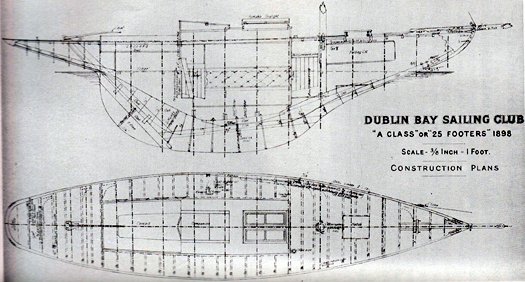
Quantum leap. The plans for the new Dublin Bay 25 in 1898. For a club which had started with small boats only fourteen years earlier, this was a remarkable development.
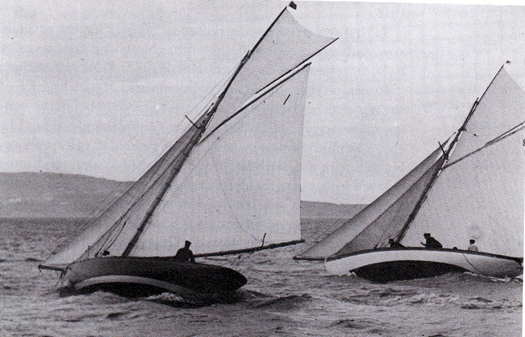
High society. DBSC member Lord Dudley racing his new Dublin Bay 25 Fodhla against R B MacDermott's sister-ship Acushla. Photo: Courtesy DBSC
Soon after, the Dublin Bay 21s hit the scene in 1902-03, and this underlined the sheer strength of the powerhouse which Dublin Bay sailing was becoming. Like it or not, it was metropolitan muscle, bringing good business to favoured boatyards near and far. There's a whole world in this photo of the Dublin Bay 21 Garavoge about to be launched in 1903 from James Kelly's little boatyard at Portrush on the North Coast.

The new Dublin Bay 21 Garavoge ready for launching in 1903 at Portrush with the DBSC burgee on stemhead, a great moment for owner W R Richardson, who stands proudly on left. Builder James Kelly, who four years later was to build the seven Dublin Bay 17s for DBSC members, is in the group on the right. Photo courtesy Robin Ruddock
Not all Dublin Bay one design and restricted classes were a continuing success. The boats built to the Half Rater rule., startlingly like early Flying Fifteens, proved too hairy and dangerous even for the hard-driving sailors of Ireland's east coast, and they were soon phased out. Then too the Colleens, ballasted centreboarders created by local builder James Doyle, capsized a couple of times too often to be cherished.
But the demise of the Colleens gave further indication of DBSC's steadily increasing power. In 1906 the Club was casting about for an able keelboat to replace the Colleens, and after much discussion they decided to use the design for the Howth 17s, which had been racing happily since 1898 as an able little keelboat one design in the waters of terra incognita way beyond Howth Head.
Herbert Boyd, Commodore of Howth SC from its inception in 1895 until his death in 1948, had designed the Howth 17s himself. But he was so chuffed that DBSC wanted to use his creation that he tidied it up, accepted that south of the Baily it would be known as the Dublin Bay 17, and even designed the option of a slightly larger cockpit, as it was acknowledged that Southsiders tended to be a little more portly than the lean and hungry Eastsiders of Howth.
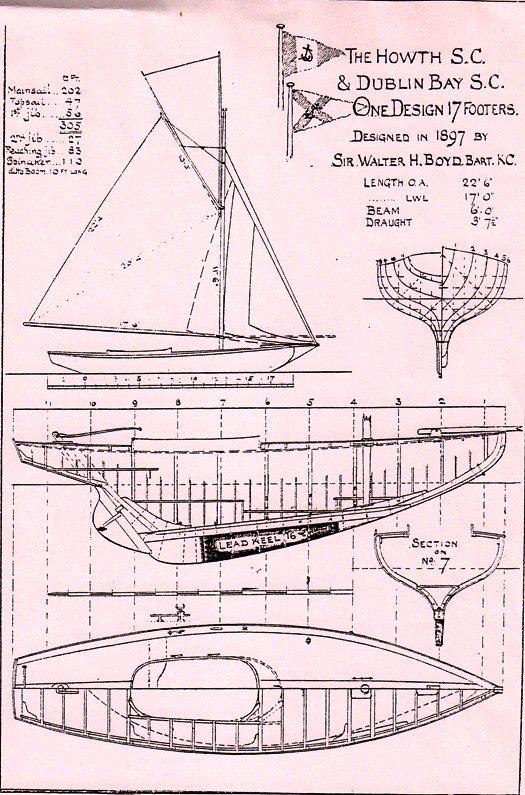
Plans of the "Dublin Bay 17" as tidied up by designer Herbert Boyd for the new Southside division of the class in 1907. As the Southsiders were better fed, they requested the option of a slightly larger cockpit.
It is now more than forty years since all the boats to the Seventeen foot design were re-grouped in Howth in 1972, yet you will still hear some absent-minded old buffers describing them as the "Dublin Bay 17s". All of which underlines the sheer power of the Dublin Bay brand. It's not that DBSC throws its weight about. On the contrary, it is a world leader in doing good work by stealth. But here it is, this enormous benign presence, and in the final analysis its word is law.
Currently, the classic case in point is the demise in Dun Laoghaire of the 17ft Mermaid Class. Designed by John Kearney in 1932 in response to requests from DBSC members, it became recognised as a class known as the Dublin Bay Mermaid in 1936. In its day, the Mermaid was a huge part of the fabric of Irish sailing, and its strength in Dublin Bay was phenomenal. But Dublin Bay moves on, however gently it may do so. Over the years it has allowed classes to wither and die as nature intended, while its members take up new boat challenges, often playing a key role in their development from the start.
So for the first time since 1936, there'll be no racing for Mermaids in Dublin Bay in 2014. Last year, they could theoretically muster half a dozen boats, but on the water the crucial figure of five boats racing to make the cut often wasn't happening. So now they're gone, to make way for new classes which rapidly achieve astonishing figures and take sailing in a fresh direction, such as the thriving First 211s.
However, part of the strength of DBSC is that the club accurately reflects what's happening afloat. Wooden boat racing may have suffered one blow with the end of Mermaid racing, but the energetic Water Wags seem to go from strength to strength. Originating in 1887, the class set a precedent in 1903 by retaining its class organisation, yet changing its boat type completely from a little double-ender to a much more substantial transom-sterned sailing dinghy, modern in its time, which today musters healthy fleet of more than two dozen.
But in a quietly but relentlessly forward-moving society like south Dublin, some boats inevitably fall by the wayside, and for wooden racing boats in Dun Laoghaire, size seems to be crucial for survival. The Water Wags may thrive, but the Mermaids – three feet longer – require that little bit of extra work, that final additional straw of shoreside man-handling which breaks the camel's back.
As for the Dublin Bay 21s and 25s and 24s, they're long gone. Whether the old 21s, mouldering in a Wicklow farmyard, ever sail again is a moot point. But it's still possible that their newer bigger sisters, the Dublin Bay 24s, will sail again as pampered toys known as Royal Alfred 38s in the South of France.
There's a considerable irony in this, as the pioneering 24s – boats conceived as slightly beefier seagoing Six Metres - were first suggested at a committee meeting of the Royal Alfred YC in 1934. It was a good idea, but the RAYC could carry it no further, so by the late 1930s they'd become the Dublin Bay 24s, and six were being built. World War II from 1939 to 1945 then interrupted their progress, but in 1947 the new Dublin Bay 24s made their debut, and they re-confirmed Dublin Bay SC in its pre-eminent role. They were brilliant boats for racing in the bay and at East Coast regattas, they could cut the mustard in RORC Racing (one of them won the RORC's Morecambe Bay race overall when it went through a gale in 1964), and they were superb fast cruisers, picking up several major ICC awards.
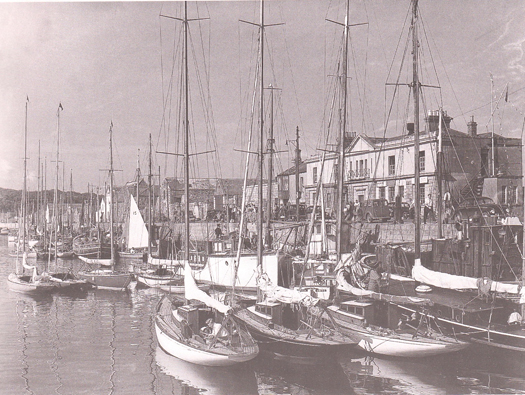
Three of the new Dublin Bay 24s make an impressive sight visiting Howth Regatta in 1953. Offering high quality racing in the bay, with wins offshore in RORC events, and proven cruising ability, in their day they were one of the most successful DBSC classes.
Yet the fact that the 24s are long gone from Dublin Bay is just the way it is. Life moves on, situations change, and DBSC - in successfully reflecting the sailing environment in which it functions - is in its understated way a genuine power in sailing, a thoroughly good thing.
It achieves this through a code of volunteerism which would be emulated by many other organisations, if only they knew the secret of the secret ingredient. It's difficult to pin it down, but the underlying DBSC ethos is found in all the memberships of the Dun Laoghaire clubs. But not necessarily in all the members. Serving Dublin Bay SC is a high calling, a vocation given only to a special few. And the people who run it are a band of brothers and sisters, who also happen to be the best of friends. The Code of the Bay is something that becomes elusive as you try to analyse it, so let's just be happy to enjoy it, savouring the wonderful sport provided by this extraordinary organisation for thousands of sailors in boats of every type.
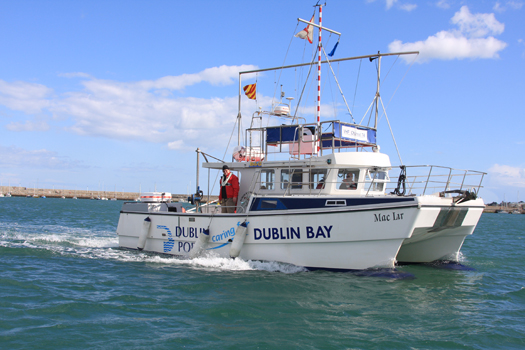
Mac Lir, one of two fast catamaran style Committee Vessels operated by DBSC on an all year round basis. Photo: David O'Brien
#dbsc – The finale of the Rathfarnham Ford Spring Chicken Series will feature an additional race held to be held on the final Sunday on 23rd March. The amendment to the sailing instructions was issued today in advance of next Sunday's racing in the 40–boat fleet. (Handicaps & Starts for next Sunday's race are attached. Although the overall results (also attached below) show a nice mix of boats at the top of the leaderboard a discard has yet to be applied. There will be no racing on Sunday 16th March.
#dbsc – A 1720 sportsboat named Deja Vu was the winner of the opening race of DBSC's Spring Chicken Series, second was the A35 Another Adventure and third was the Beneteau 34.7 Adelie. Full results are downloadable below. The six weeek series got off to a perfect start last weekend and the hope is a similar weather window might present itself again in the next 48–hours for the National Yacht Club hosted event. Attached are results from last Sunday and also Starts & Handicaps for this weekend.
Sunday's DBSC Spring Chicken Sailing Series Draws 40–Boat Fleet for First Event of 2014
#dbsc – Two Sailing School 1720 sportsboats from the Irish National Sailing School (INSS) in Dun Laoghaire are part of a 40–boat Dublin Bay Sailing Club (DBSC) Spring Chicken Series that starts tomorrow at the National Yacht Club. See entry sheet downloadable below.
Organisers are hoping that today's westerly storm blows through as forecast for the first race tomorrow morning. There will be four starts (see xcel sheet downloaadble below) for the handicap fleet. The February event is sponsored by Rathfarnham Ford.
DBSC Launches 2014 Spring Chicken Series at the National Yacht Club
#dbsc – The National Yacht Club will host Dublin Bay Sailing Club's Spring Chicken series starting on 2nd February and running until March 9th. It follows the 70–boat Turkey shoot that ran up to Christmas. Both series are being sponsored by Rathfarnham Ford. Entry form and a Notice of Race are attached for download below.
A series of six races will be held on Sunday mornings on Dublin Bay and scored under modified ECHO. Cruisers, cruising boats, one-designs and boats that do not normally race are very welcome, according to race organiser Fintan Cairns.
Again, as an incentive to get people sailing, a boat that takes out a NON-SAILOR (new to sailing) will get a 2% discount on it's handicap that day. The non-sailor will qualify as such for 3 races if taken. Names must be registered before sailing on the day.
The entry fee of €60.00 includes temporary membership of Dublin Bay S.C. and National YC
Irish National Sailing Club (INSC) Compete at DBSC Turkey Shoot
#dbsc– The Irish National Sailing Club (INSC) competed in the Rathfarnham Ford sponsored DBSC Turkey Shoot Series 2013. Here, club skipper Kenneth Rumball (also the Irish Fireball dinghy champion), reviews the school's performance and concludes how evenly both boats were matched over the seven race series.
Sunday the 3rd of November and the two Irish National Sailing Club race teams, INSC 1 skippered by Alexander Rumball and INSC2 skippered by Kenneth Rumball made their way across to the Royal Irish Yacht Club where the boats were on the pontoons ready for the first race of the 2013 Rathfarnham Ford Turkey Shoot series.
With an awful forecast and many crews wondering if we would actually be racing, our teams rather nervously readied the boats to head out in a steady 25-30kts. Being one of the first boats to launch, we headed out and blasted out to wards the committee boat with only our mainsails up followed later by the rest of the fleet. This was our first race for our crews with absolutely no prior training with their respective helms in the 1720s due to rough weather. As such an initial race in 30kts in a 1720 was more a case of holding on and just getting around the race track, not even a mention of spinnakers!
Race two on the 10th of November greeted us with conditions more suited to the 1720, a gentle 12kts from the South West decreasing during the morning. This allowed us to really concentrate on the racing and get all crews used to the spinnakers and how to handle them. In the lighter conditions, we were more up towards to the top of the pack chasing for line honours.
Race three and four saw both boats improving all the time. Both teams were now fighting with the like of Prof in the J70 and Déjà vu the 1720 from the NYC in original form. This tight racing in the light airs was brilliant for our crews, really seeing what the good sailors at the top end of the fleet are aiming towards. Hard lessons were learnt and concentration really was key to success in these races. There was a healthy rivalry developing between the younger crew on INSC1 and wiser crew on INSC2. Both crews were becoming constantly aware of where the other boats were. At the end of race four, both boats were lying joint 9th overall!
The fifth race of the series saw Fintan and his team send us off on a short upwind followed by a long downwind with the Muglins being the leeward mark. INSC1 took an early lead over INSC2 on this long spinnaker leg down to the Muglins, getting towards it Kenneth on INSC2 was still a bit behind but wanted to get ahead. Some great spinnaker work by the crew with a flawless kiwi drop of the kite while the helm took such a tight line around the island, one could have potentially reached out over the side of the boat and touched the rock saw us sail inside INSC2 and Déjà vu amongst others. A short beat up towards Loreto Dalkey with a strong ebb tide saw a great corss tacking phase between INSC2 and Mermaid, the eventual overall winner. INSC1 stayed close in phase but after a great comeback it was INSC2 on top in joint 4th and INSC back in unlucky 13th.
Lots to play for in the last two races, race six saw both boats and their main rivals sporting an OCS on the scoreboard so nothing too much to report from that race. Our final race last Sunday was according to the forecast to be potentially blown out, however hugely light conditions off the start line saw us sailing with two crew situated on the leeward side of the boat! Tight racing between all the 1720s and the J70 had us all bunched together at the top mark. All 1720s were sporting the smaller 'chicken' or fractional kites due to the sever forecast. A good hoist followed by a faulty slef tripping fractional kite halyard meant INSC2 suffered a severe setback, retrieveing their kite from the sea whil rushing to rig the mast head. INSC1 took control of the race on the next downwind and on the next tricky beat they at one stage took the lead in the race. Rounding the next top mark, INSC2 had been catching up and INSC1 took the go big or go home approach, with both boats throwing the mast head kites up in a strengthening breeze. Good speeds and big smiles as both crews had the most memorable downwind ride of the series.
Here is a short view from one of our crews, Pat;
'Throwing 5 people together, on a windy October Sunday morning, who had never me each other before, with a 40 year age gap range, was the start of a marvellous 7 Sunday expose to racing on a 1720 in Dublin Bay. Most of us had limited knowledge of sailing so the initial drills and exercises were somewhat daunting especially when it came to flying the kite.
By the end of the race series we had learned a lot, had become dab hands at handling kites and got to know each other as if we had been ship mates for years'.
With INSC1 finishing 11th and INSC2 13th in the overall results, it shows how evenly the boats were matched. Both crews had an excellent time on their skippers wish to see them bringing their skills onto other boats in Dun Laoghaire.
The INSC will have boats entered in the DBSC Spring Chicken series so if you want to experience racing at the top end of the fleet followed by weekly email de-briefs accompanied by top tricks, hints and tips, don't wait and sign up as spaces are limited!
DBSC Turkey Shoot 2013 Won By a Mermaid
#dbsc – Neither a J109 or a 1720 sporsboat could match the pace of the consistent performance of the Beneteau First 50, (Seamus Fitzpatrick) the overall winner of the 2013 Rathfarnham Ford sponsored DBSC Turkey Shoot that concluded on Dublin Bay yesterday in moderate to strong conditions.
The J109 Indecision (Declan Hayes and others) was second overall to Mermaid IV, by a margin of 20 nett points.
It was only the second time in the 12–year history of the series that the full seven race series was completed.
Third was the Cartoonist, a 1720 (Ken Lawless and others) just two points behind the J-boat. Full race results for yesterday are downloadable below with overalls series results also available below.
#dbsc – The Beneteau 50 Mermaid IV will continue her long standing lead into the final race of DBSC's Turkey Shoot takes place this Sunday morning with an expected 70-boat turnout for the climax of the six week Dublin Bay series. Second overall is White Knight trailing by 12 points. Overall results for the Rathfarnham Ford sponsored series are downloadable below.
Racing in a mixed fleet of cruisers – from 20 foot to 50 foot – has been taking place each Sunday morning since 3rd November and concludes this Sunday, 15th December.
Racing is held under modified ECHO (i.e. time on time) and handicaps have been recalculated weekly during the series. An overall prizegiving will takes place after racing at the RIYC.
Mermaid Rules the Waves at DBSC Turkey Shoot
#dbsc – The Beneteau 50 Mermaid IV continues to lead the 70–boat Rathfarnham Ford sponsored Turkey Shoot series. Fives races have been sailed with one discard applied. Results are downloadable below as a word file. Second overall is Fox in Sox and third is the J109 Indecision.
Dun Laoghaire Yacht Club Cuts Fee for New Members to €175
#dmyc – The Dun Laoghaire Motor Yacht Club (DMYC) has announced a new introductory membership fee. New members can now join for just €175 and enjoy all the facilities the Club has to offer. This rate will be for 2014, again in 2015 with the full rate of applicable membership (crew, ordinary etc.) applying after the two years. It might be a good way to introduce a friend, family member, business colleague to the water through the DMYC. It might even solve that age-old problem – “what do I get her/him/them for Christmas?”. Contact Karin in the office 01 2801371 or email [email protected].


























